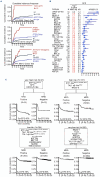Relapsed childhood T-cell acute lymphoblastic leukemia and lymphoblastic lymphoma
- PMID: 39781622
- PMCID: PMC12399950
- DOI: 10.3324/haematol.2024.285643
Relapsed childhood T-cell acute lymphoblastic leukemia and lymphoblastic lymphoma
Abstract
While outcomes for pediatric acute lymphoblastic leukemia (ALL) and lymphoblastic lymphoma (LBL) have improved dramatically in recent decades, relapsed and refractory disease remain a significant therapeutic challenge. This is particularly true for patients with T-cell ALL and LBL, where survival for patients with relapsed/refractory disease remains dismal. Recent efforts to comprehensively profile the genomics of T-ALL/LBL to improve understanding of disease biology have enhanced our ability to identify high-risk patients at diagnosis who are more likely to relapse and have also identified novel targets for precision medicines. Novel immunotherapies have transformed the treatment landscape for patients with B-cell ALL (B-ALL). Many immunotherapies are under investigation in clinical trials for patients with T-ALL/LBL and early results are very promising. Given these insights into disease biology and the development of targeted and immune-based treatments, it is reasonable to hope for improved patient outcomes, although challenges remain. In this review, we summarize the present state of understanding of the risk factors for relapse of T-ALL/LBL, established treatment regimens, and the promising small molecule inhibitors and immunotherapies with the potential to revolutionize the treatment of relapsed/refractory T-ALL/LBL.
Figures

References
-
- SEER*Explorer:an interactive website for SEER cancer statistics [Internet]. Surveillance Research Program, National Cancer Institute; April 17, 2024. https://seer.cancer.gov/statistics-network/explorer/ Accessed September 13, 2024.
-
- Rheingold SR, Ji L, Xu X, et al. Prognostic factors for survival after relapsed acute lymphoblastic leukemia (ALL), a Children’s Oncology Group (COG) study. J Clin Oncol. 2019;37(Suppl 15):10008.
Publication types
MeSH terms
LinkOut - more resources
Full Text Sources

